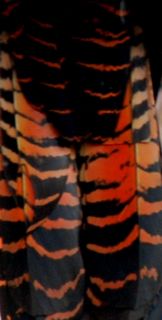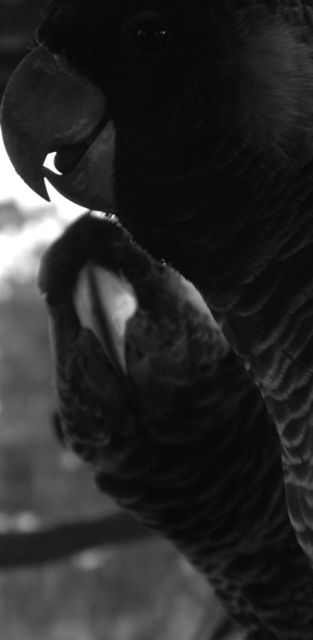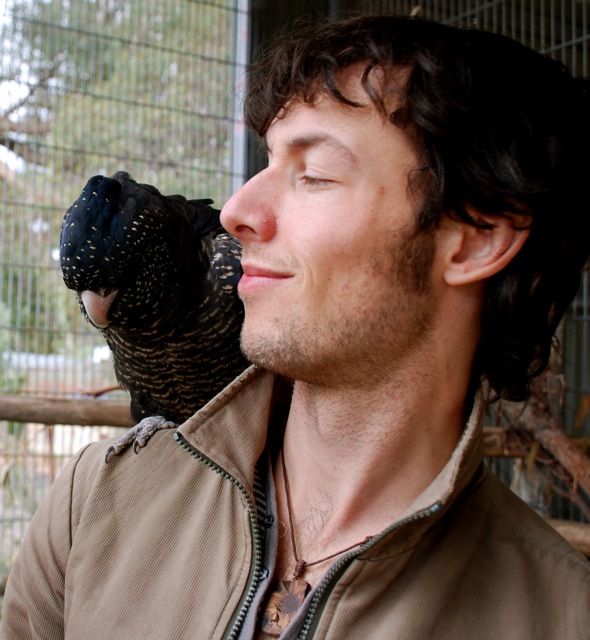I have two long black feathers, one tipped with a streak of scarlet red and the other with a flag of pure white, near me as I write. The Nyoongar people sometimes wore such feathers in their head bands or on their arms. For me I will keep these near me as a symbol of the last of the wild in south-western Australia.
This afternoon I went up to visit Glenn Dewhurst in the hills directly east of Fremantle at the headquarters of the Black Cockatoo Preservation Society. I interviewed Glenn on Understorey on RTR 92.1 FM earlier this week about the work of his organization, and had been invited by him to come up for a visit to his aviaries. There are many well paid professionals in the area of environmental conservation, working for WWF for example, or for the Department of Environment and Conservation in government. Don’t get me wrong, I am sure they do good work, but many don’t obviously shine with a light of passion or love for the ultimate end of their work. Glenn Dewhurst does. He is not well paid. He is not a bureaucrat. He is not career-focused. He is an honest champion of the birds he loves.
Glenn lives with his wife and three young children on 12 acres in Martin, covered in marri trees. It is quite green out there at the moment after weeks of rain. Glenn has a large number of aviaries for Carnaby’s, Baudin’s and Naso (red-tailed) cockatoos that he is rehabilitating and preparing for release back into the wild. He can even find the original flock of the injured bird and return it to the original family – something which would bring great joy to parents who probably thought their child dead. He took me and a friend into one of the aviaries down the hill where two Naso’s are being rehabilitated. We entered the aviary and looked around us. One of them he had spent countless hours with nursing it back to life after it had been hit by a car. This fella, by the name of Retep, was quite curious and affectionate. Generally Glenn doesn’t encourage this kind of human intimacy with the birds as they will ultimately be released into the wild when they are fit and ready and such behaviour won’t help them later on. However for Retep so much care had been necessary to keep him alive that it was to late to completely cut out his familiarity with humans. He came over and landed on my arm, then walked up and sat on my shoulder (I now more easily understand how mariners in centuries past managed to end up with pet parrots from the tropics sitting up along side). Parrots are very social and highly intelligent animals, I’ve known this intellectually at least for a while. But to have a very large black cockatoo sitting with me this afternoon, on my shoulder, looking for a bit of warmth and interaction, was touching. Retep bobbed and huddled closer in the winter’s air. A bit of inter-species communication was taking place on a cool afternoon in July.

Watching some videos of the couple who helped set the Black Cockatoo Preservation Society up during the week I was reminded of how much of a symbol of the last of the wild in Perth these large and beautiful birds are (the red-tailed birds are declining thanks to shooting by farmers, poaching and other threats in their jarrah forests, but Carnaby’s is more of the woodland dweller). If we can save the Carnaby’s cockatoo, then we will have to save a lot more of the land around Perth on the Swan Coastal Plain from developments such as the one planned by Bells Rapids (where the Swan river enters the hills) or the one planned by a Japanese corporation up at Yanchep. And if we can do that we will have saved the habitat of hundreds of species of reptiles, invertebrates and other biodiversity. In this way Carnaby’s black cockatoo is the best symbol that we have of the last of the wild in Perth. As ugly housing developments are built, they lose their homes. As the wild goes, they are going.
 Glenn told me that a flock of 150 came into his area in the last month. He watched them fly down to the coastal plain, but very soon they were back in the marri trees of the Darling Ranges where he lives, looking for marri and jarrah nuts. Glenn thinks it is likely that they didn’t find the woodland habitat they were looking for down on the plain because of all the new housing developments. This year is the first time he has seen this happen.
Glenn told me that a flock of 150 came into his area in the last month. He watched them fly down to the coastal plain, but very soon they were back in the marri trees of the Darling Ranges where he lives, looking for marri and jarrah nuts. Glenn thinks it is likely that they didn’t find the woodland habitat they were looking for down on the plain because of all the new housing developments. This year is the first time he has seen this happen.
Wee-loooo, wee-loooo, wee-looo. Endangered sounds from above. Suddenly the large group passed across above us, and the birds in the aviaries called out in excitement to their cousins.
These birds are such proud, complex and beautiful beings. Their tall heads, graceful wing lines, lustrous black body set off by white or glowing red tail-feathers, and most of all, their curious and emotionally-nuanced personalities, make them the best symbols of the old, wild Australia that we have around here. Being with them today inspired me. I was looking right into the face of the last of the wild in Perth. Those dark eyes made me want to protest the destruction of nature at this cities boundaries more than ever.

Hi Tom, It’s fantastic to see these wonderful endangered cockatoos featured here, along with the work Glenn, Andrea & their team are doing… 🙂 Great website too. I have just extended my ‘to read’ list. Cheers, Sonia
Hi Tom,
Great article and great to hear from someone who recognises “the cause”. Yes, they are a magnificent and very special bird …. in the parrot world they are uniques in-so-far as they inherently gentle. Anything you can do to further the cause would be greatly appreciated by all of us who volunteer for, and believe in the work that Glenn, his extended family and all who work for the preservation of our wildlife and environment.